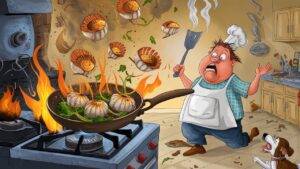Scallops are a delicacy known for their tender texture and sweet, buttery flavor. However, they are also delicate and easy to overcook or mishandle, leading to a rubbery texture or lackluster flavor. So, what should you avoid when cooking scallops to achieve that perfect sear and melt-in-your-mouth tenderness?
In this article, we’ll explore the common mistakes to avoid when cooking scallops, from selecting the right scallops to perfecting your cooking technique. Whether you’re a seasoned cook or trying scallops for the first time, this guide will help you master this luxurious seafood. For more ideas on how to incorporate scallops into your meals, check out these shrimp and scallop recipes.
What Are Scallops?
Before diving into the common mistakes, it’s important to understand what scallops are and why they require special attention during cooking. Scallops are a type of shellfish belonging to the mollusk family. They are prized for their slightly sweet, delicate flavor and tender texture, making them a popular choice in fine dining and home kitchens alike.
There are two main types of scallops commonly found in grocery stores and restaurants:
- Sea Scallops: Larger and typically 1.5 to 2 inches in diameter, these are perfect for searing and grilling. They are often featured in elegant dishes where presentation matters.
- Bay Scallops: Smaller, around 1/2 inch in diameter, and usually sweeter than sea scallops, these are ideal for stews, pastas, and quick-cooking dishes.
What Not to Do When Cooking Scallops: Common Mistakes to Avoid
Cooking scallops may seem straightforward, but several mistakes can lead to disappointing results. Below are the top things not to do when cooking scallops, along with expert tips to help you avoid these common pitfalls.
1. Don’t Buy Wet Scallops
One of the most common mistakes starts before you even begin cooking: buying wet scallops. Wet scallops have been soaked in a phosphate solution, which causes them to absorb water. This extra moisture leads to a rubbery texture and bland flavor when cooked.
- What to Do Instead: Always opt for dry-packed scallops, which haven’t been treated with chemicals. Dry scallops have a more concentrated flavor and are much better for searing. If you’re unsure, ask your fishmonger if the scallops are dry-packed or wet-packed.
2. Don’t Skip the Drying Step
Moisture is the enemy of a good sear. One of the biggest mistakes people make when cooking scallops is not drying them thoroughly. If your scallops aren’t dry, they will steam in the pan instead of searing, resulting in a pale, soggy exterior rather than the golden-brown crust you want.
- What to Do Instead: After rinsing the scallops, pat them dry with paper towels and let them sit on a towel-lined plate for a few minutes to absorb any remaining moisture. The drier the scallops, the better they will sear.
3. Don’t Overcrowd the Pan
Overcrowding the pan is another common mistake. When too many scallops are added at once, the temperature drops, causing the scallops to release moisture, which leads to steaming rather than searing.
- What to Do Instead: Cook the scallops in batches, ensuring there is enough space between each one. This allows the pan to maintain its heat, resulting in a beautifully seared exterior. Use a large skillet, such as a cast iron or stainless steel pan, which can hold heat well.
For more tips on cooking seafood, explore this guide on what goes well with shrimp.
4. Don’t Use the Wrong Pan
Using the wrong type of pan can prevent your scallops from developing that perfect golden-brown crust. Non-stick pans, while convenient, don’t allow scallops to brown properly. Additionally, pans that don’t retain heat well can lead to uneven cooking.
- What to Do Instead: Use a heavy-bottomed skillet, such as cast iron or stainless steel, for the best sear. These pans retain heat better, which helps create that perfect crust on your scallops.
5. Don’t Cook Scallops Straight from the Fridge
Cooking scallops straight from the fridge can lead to uneven cooking, with the outside becoming overcooked while the inside remains undercooked. The temperature contrast can cause scallops to seize up and become tough.
- What to Do Instead: Let the scallops come to room temperature for about 15 minutes before cooking. This helps them cook more evenly and prevents them from becoming rubbery.
Part 2: Mastering Scallop Cooking Techniques

Now that you know what not to do when cooking scallops, let’s explore the steps for cooking scallops perfectly every time. These tips will help you achieve that golden-brown crust and tender interior that make scallops such a luxurious treat.
6. Don’t Overcook the Scallops
One of the most critical mistakes is overcooking scallops. Because they are delicate, scallops cook quickly, and leaving them on the heat for too long can result in a tough, rubbery texture.
- What to Do Instead: Scallops typically need about 1.5 to 2 minutes per side when searing. They should be opaque in the center and have a golden-brown crust on the outside. Remove them from the heat as soon as they reach this point to avoid overcooking.
7. Don’t Season Too Early
Seasoning too early can cause scallops to release moisture, making them difficult to sear properly. Salt, in particular, can draw out liquid if added too far in advance.
- What to Do Instead: Season the scallops with salt and pepper just before cooking. This will ensure that they stay dry enough to sear while still being properly seasoned.
8. Don’t Forget to Use High Heat
Cooking scallops over low or medium heat will prevent them from achieving the perfect sear and can lead to a less-than-ideal texture. High heat is necessary to quickly caramelize the exterior without overcooking the inside.
- What to Do Instead: Preheat your pan over medium-high to high heat before adding the scallops. Ensure the pan is hot enough to create a sizzling sound when the scallops are placed in it. This high heat will help you achieve the ideal sear.
For more seafood inspiration, check out this miso-glazed coho salmon recipe for another delicious way to enjoy seafood: Miso-Glazed Salmon Recipe.
How to Cook Scallops Perfectly: Step-by-Step Guide
Now that you know the pitfalls to avoid, here is a step-by-step guide to cooking scallops perfectly every time.
- Choose the Right Scallops: Opt for dry-packed sea scallops for the best flavor and texture.
- Dry the Scallops Thoroughly: Pat them dry with paper towels and let them sit for a few minutes to absorb any remaining moisture.
- Bring the Scallops to Room Temperature: Let them sit at room temperature for 15 minutes before cooking to ensure even cooking.
- Preheat the Pan: Use a heavy-bottomed skillet and preheat it over medium-high heat. Add a small amount of oil with a high smoke point, such as vegetable or grapeseed oil.
- Season the Scallops: Season just before cooking to prevent moisture loss.
- Sear the Scallops: Place the scallops in the hot pan, leaving space between each one. Sear for 1.5 to 2 minutes per side without moving them around. Flip and sear the other side for the same amount of time.
- Finish with Butter and Aromatics: For added flavor, finish the scallops with a small pat of butter and aromatics like garlic, thyme, or lemon zest.
- Serve Immediately: Scallops are best served right after cooking while they are still warm and tender.
FAQs About Cooking Scallops
1. How Can I Tell When Scallops Are Done?
Scallops are done when they are opaque in the center and have a golden-brown crust on the outside. They should feel slightly springy to the touch but not mushy or rubbery. Overcooked scallops will be tough, so it’s important to remove them from the heat as soon as they reach the desired doneness.
2. Can I Cook Frozen Scallops?
Yes, you can cook frozen scallops, but it’s essential to thaw them properly before cooking. Thaw scallops in the refrigerator overnight or place them in a sealed bag and submerge them in cold water for a quicker thaw. Once thawed, pat them dry thoroughly to remove excess moisture.
3. Should I Brine Scallops Before Cooking?
Brining scallops can enhance their flavor and help them retain moisture during cooking. To brine scallops, dissolve 1/4 cup of salt in 1 quart of cold water. Soak the scallops in the brine for 10-15 minutes, then rinse and dry them before cooking. This step can improve the texture of the scallops and add a subtle seasoning.
Conclusion: What Not to Do When Cooking Scallops
Cooking scallops to perfection requires attention to detail and avoiding common mistakes. From selecting the right scallops to mastering the cooking technique, knowing what not to do when cooking scallops will help you achieve tender, flavorful results every time.
By choosing dry-packed scallops, drying them thoroughly, using the right pan, and avoiding overcrowding, you can ensure that your scallops are perfectly seared and delicious. Remember to use high heat, season just before cooking, and avoid overcooking to maintain their delicate texture. Discover more shrimp and scallop recipes for your next meal.

